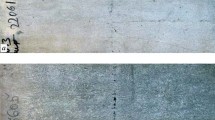Conclusions
The effect of lead on the fatigue strength of structural steels and their susceptibility to embrittlement during heating is due to the difference in the coefficient of thermal expansion of lead particles and iron with heating of lead-containing steels and to the mosaic stresses resulting from this, which induce fracture and prefracture, and also the influence of liquid lead as a surface-active substance with regard to the steel. These characteristics of the behavior of lead particles in steel in the cutting zone at high strain rates are accompanied by an increase of temperature and promote better machinability of the steel in comparison with the steel without lead. On the basis of the results we do not recommend lead-containing steel for parts subject to fatigue and having high strength σb<1200–1400MPa) or for parts heated to 200–500° in the course of operation.
Similar content being viewed by others
Literature cited
Ya. E. Gol'dshtein, A. Ya. Zaslavskii, and B. S. Starokozhev, “Effect of lead on the fatigue characteristics of structural steel,” Metalloved. Term. Obrab. Met., No. 5, 31 (1973).
W. Bardett, J. Iron Steel Inst.,29, No. 4, 392 (1956).
V. S. Ivanova and V. F. Terent'ev, Nature of the Fatigue of Metals [in Russian], Metallurgiya, Moscow (1975), p. 456.
R. V. Romashov and V. V. Fedorov, “Experimental verification of thermodynamic concepts of the failure of solids in the process of fatigue tests,” Zavod. Lab., No. 2, 229 (1975).
L. A. Gorbachev, “The fatigue equation under steady loading conditions,” Zavod. Lab. No. 12, 1500 (1975).
L. N. Molchanov and N. I. Kharitonov, “Effect of heating in the course of testing with overloading on the low-cycle fatigue strength,” Zavod. Lab., No. 12, 1508 (1965).
Yu. I. Ryzhakov and V.S. Dronov, “Method of measuring the temperature of a revolving sample in fatigue tests,” Zavod. Lab., No. 4, 484 (1972).
Yu. I. Ryzhakov and L. N. Molchanov, “Effect of some characteristics of scattering of heat occurring with over loads on the fatigue strength of medium-carbon steels,” Probl. Prochn., No. 9, 114 (1977).
V. S. Dronov and A. N. Kharitonov, “Development of cyclic deformation in steel with overloading during the test,” in: Problems of Metal Science and Physics of Metals [in Russian], Tula Polytechnic Inst. (1972), p. 192.
F. Laszlo, “Tesselated stresses,” JISI,152, 207 (1945).
A. B. Kuslitskii, Nonmetallic Inclusions and Fatigue of Steel [in Russian], Tekhnika, Kiev (1976).
V. I. Nizhenko and V. N. Eremenko, “Surface activity of additions to liquid metals,” Poroshk. Metall., No. 2, 12 (1964).
Yu. V. Naidich, Contact Phenomena in Metallic Melts [in Russian], Naukova Dumka, Kiev (1972).
V. I. Likhtman, E. D. Shchukin, and P. A. Rebinder, Physicochemical Mechanics of Metals [in Russian], Izd. Akad. Nauk SSSR, Moscow (1962).
W. Rostoker, J. M. McCaughey, and H. Markus, Embrittlement by Liquid Metals, Reinhold Publ. Corp., New York (1960).
N. Breyer and P. Gordon, “Lead induced brittle failures of high strength steel,” in: Microstruct. and Design Alloys, Proc. Third Int. Conf. Strength Metals and Alloys, Cambridge, s.n., Vol. 1 (1973), p. 493.
I. K.Kikokin (ed.), Tables of Physical Values (Handbook) [in Russian], Atomizdat, Moscow (1976).
Additional information
Scientific-Research Institute of Metallurgy, Chelyabinsk. Translated from Metallovedenie i Termicheskaya Obrabotka Metallov, No. 11, pp. 6–8, November, 1980.
Rights and permissions
About this article
Cite this article
Zaslavskii, A.Y. Effect of lead on the properties of structural steel. Met Sci Heat Treat 22, 783–787 (1980). https://doi.org/10.1007/BF00779425
Issue Date:
DOI: https://doi.org/10.1007/BF00779425




